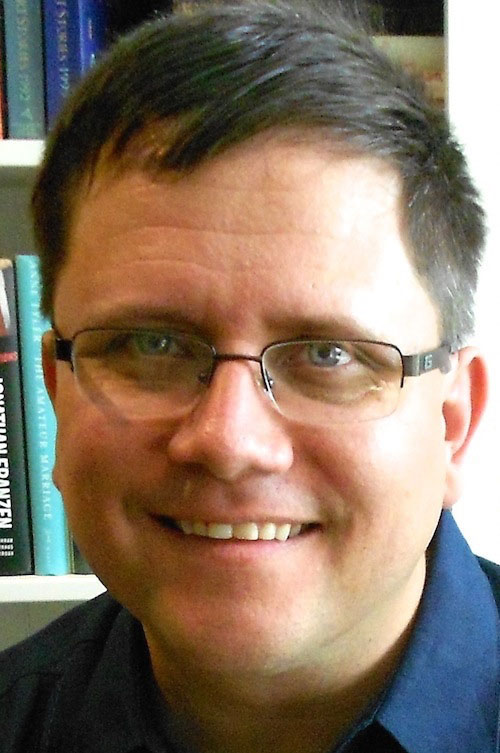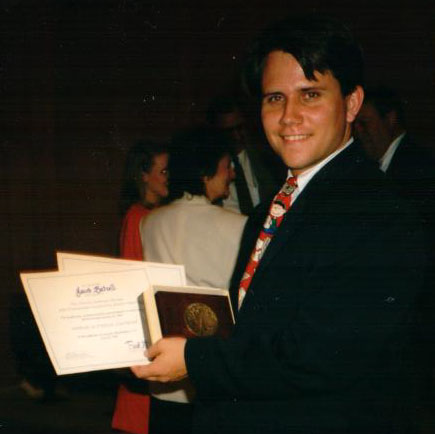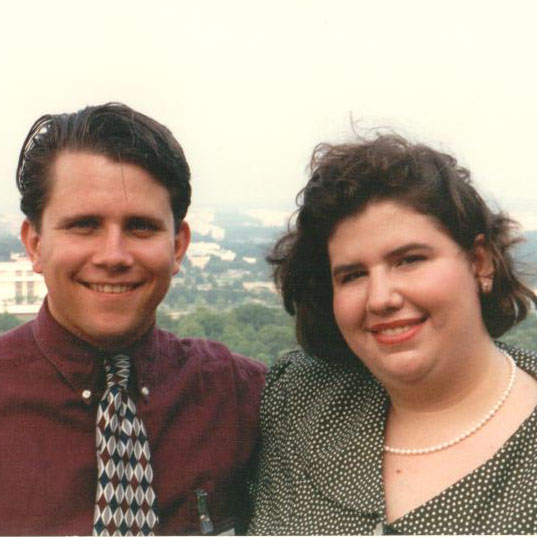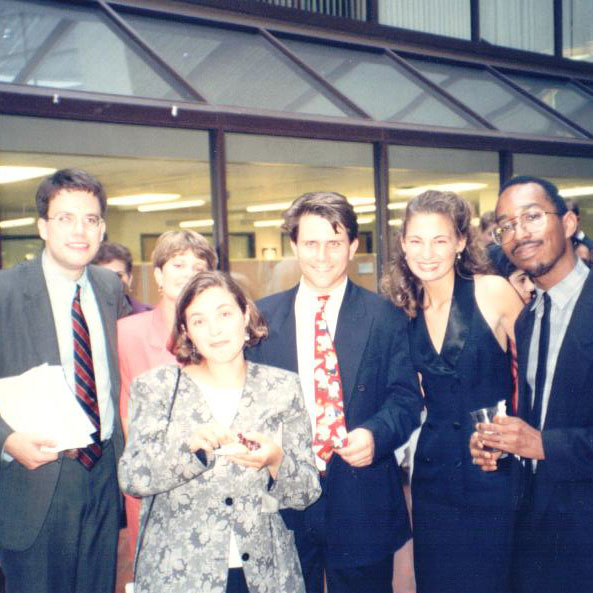
Jake Batsell (IPJ 94) is an assistant professor at Southern Methodist University’s Division of Journalism in Dallas, where he teaches digital journalism and media entrepreneurship. His book, “Engaged Journalism: Connecting with Digitally Empowered News Audiences” (Columbia University Press, February 2015) examines the changing relationship between journalists and the audiences they serve. Batsell, previously a staff writer for the Seattle Times and Dallas Morning News, spent the 2013-14 academic year at The Texas Tribune in Austin as part of a Knight Foundation fellowship to research best practices in the business of digital news. Batsell completed the TFAS Institute on Political Journalism in 1994.
Jake Batsell (IPJ 94) just released his book “Engaged Journalism: Connecting with Digitally Empowered News Audiences” this February. TFAS spoke with Batsell to get the inside scoop about the book, its themes and his TFAS experience.
How did you get started in journalism?
I am one of those rare creatures who sort of knew what he wanted to do since elementary school. I somehow caught the journalism bug growing up by reading the box scores in the newspaper and the comics on Sundays. No one in my family is a journalist but somehow I caught it. My earliest click as a journalist goes back to when I self-published my own newspaper called Fifth Grade Weekly Magazine that I had my teachers photocopy and distribute to the class. I interviewed my teacher and did a review of the movie Ghostbusters. I’ve just always known that I wanted to be a journalist or in journalism in some form.

What attracted you to the IPJ program?
A lot. I was looking for some kind of a DC experience, where I could both study journalism and practice it. The combination of both, with the IPJ program, perfectly matched what I was looking for at the time. The experience couldn’t have been better. I interned with the Arizona Republic of Washington, D.C. Bureau, and got to cover some really interesting stories, basically operating as the second reporter in a two-person bureau. I just really got to dive in and sink or swim. I swam more than I sunk all while taking classes. “Ethics in the Media” and also “Economics and Public Policy” were just really fundamental in shaping and deepening the knowledge of the profession I loved so much. It couldn’t have worked out any better and I made life-long friendships and connections and relationships that I maintain to this day. Now I am in a position where I can try to encourage my students to attend IPJ, which one student is going to be doing this summer from SMU.
Did TFAS help jump start your career?
Yeah, absolutely! To come back from that summer with a fistful of clips with a Washington dateline – covering things like Barry Goldwater testifying before Congress, about the helicopters over the Grand Canyon and Steven Spielberg testifying about hate crimes in the aftermath of Schindler’s List – that gave me a huge point of distinction in terms of applying for future jobs. Without that summer I don’t know that I would have had as competitive of a background to be able to apply for things like The Seattle Times three year residency program, which was my first full-time job out of college, or internships at The Chicago Tribune and The San Jose Mercury News. A lot of it really built on that summer I spent in D.C. and showing that I could carry my own amidst the Washington, D.C. press corp. It was a huge jump-start to my career.
What prompted you to write your book, “Engaged Journalism Connecting with Digitally Empowered News Audiences?”
Well, I had written a couple of articles for Columbia Journalism Review (CJR) about different types of experiments that were going on in audience engagement. The first one was the first definitive early profile of the Texas Tribune and how they were fairing six months into their experiment. [Editor note: The Texas Tribune is a digital-first media organization that was founded in 2009.] About a year and a half later I did another article for CJR about real-time coverage of high school football in the Dallas Fort Worth area. Both of those articles really got me interested in the idea of the changing relationship between journalists and the audiences that they serve. I saw an industry that was fundamentally changing from what I had been taught – and how most of my career had gone – which was largely focused on the product of journalism and the craft of journalism and did not put a whole lot of thought into what the audience wants and needs. It began a journey where I was able to generously get some time off from the Meadows School of the Arts at SMU where I work and received some traveling grants to start visiting different types of newsrooms all around the country. It all came down to how are all of these news organizations having the two-way conversation with their audience. It’s crucial to surviving in today’s journalism world. It’s not a one-way lecture anymore. It’s not “I’m the journalist. I am the expert and I am going to impart the news to the audience and they are going to take it whether they like it or not.” The audience has so many choices these days that you, as a journalist, have to earn the audience’s attention with your work at every step. So that is the underlying theme of the whole book.

In 140 characters or less, how would you summarize the book?
Engagement is crucial to journalism’s survival. But to be effective, it must fill a specific audience need. And it comes with perks & costs.
How has the relationship between journalists who produce content and the public who consumes it changed?
It is a constant interaction as opposed to one-way delivery. I kind of start the book in the preface with a confessional that for much of my career I took the audience’s attention for granted. I assumed – arrogantly, in retrospect – that everyone that subscribed to The Seattle Times or everyone who subscribed to the Dallas Morning News was recklessly reading my stories the next day about the point of the city council or the downtown parade on Saturday. In reality, only a small percentage of subscribers ever really read my stories. A lot of times they were buying the newspaper for the classifieds or the comics or the crossword or Sudoku puzzle. Because newspapers had a relative monopoly over print advertising at the time, journalists could arrogantly assume that we didn’t have to actively earn the attention of our audiences because where else were people going to go for coverage of the information they wanted. What fundamentally changed is now the audience has infinite choices. They can go as wide or as deep on a subject as they want with a simple Google search. You can’t just rely on the distribution of that monopoly anymore, you have to actively earn your audience’s attention. That doesn’t mean you completely feed or concede news judgment to the crowd. It’s still a mix of journalistic training and instincts and fairness and accuracy in combination with an understanding of what the audience wants. Everything is measurable these days, so it is much more important to actively understand what your audience wants and use that to form your coverage plans at every step of the way because if you don’t there are other options that people can go to. Audience engagement is really, really important to build the loyalty that is necessary to survive financially, journalistically and otherwise.
What is next in journalism? Do you anticipate any drastic changes?
The standards of good credible journalism aren’t going to change. But the way we reach audiences is just changing at a very fast speed. I was asked yesterday that if I could have written a sixth chapter to my book – which is five chapters – what would it have been, and it would be about mobile and wearable technology. I really only kind of scratched the surface of it in the book and I did that by design because I knew things were changing so fast that any statistics that I included in the book about mobile would be outdated by the time the book came out. Things like the Apple Watch and the increased acceleration of mobile adoption around the world and location based technologies, it’s going to deliver an even more personalized information experience. The public is going to need to come to terms with sacrificing a little bit of their privacy if they want to take full advantage of that. Some might want to opt out of that, but I think most of the public will appreciate the value of being at the airport and getting a push notification about flight delays based on their location or weather delays. The intersection of mobile and location based technology and wearables, I think, are going to even further accelerate the change in journalism as we know it.
What advice do you have for young journalists?
Do as much work as you can. Writing is still at the epicenter of being a great storyteller, but add versatile skills to your platform. Be able to tell a story in different ways. First through words, but also through sound, multimedia, video and social media. You don’t have to tell every story in every possible way, but knowing and having just basic functionality and awareness of all these different platforms and having the judgment to decide which of those platforms best fit the story that you are working on is going to be a really key skill for journalists of the future. Another thing is to realize that you are writing for an audience. A lot of journalism students really only think of their audience during their undergraduate education as their professor, and so they write assignments for classes and try to appeal to the whims of the professor to get whatever grade they might want. But I think that any chance that you have, whether that be through student media or internships or even creating your own blog, you should be writing for a real audience so your work is circulating and getting feedback. You are an active part of this changing media ecosystem and that is going to really give you a leg up and make you more hirable and marketable. Every news organization is increasingly understanding the importance of serving and fulfilling the audience’s needs and wants in their quest to survive.
What is your favorite TFAS memory as a student in the program?
I shared some of the highlights journalistically, such as just having a Congressional credential around my neck and being able to cover the Steven Spielberg hearing about hate crimes at the U.S. House. I was at the press table sitting next to Dave Barry, a humor columnist, who was doing a week-long spoof on Washington. He was just the most humble guy. I shook his hand and he said, “Hi, I’m Dave Barry” and I was like “Yeah, I know.” He started cracking jokes about all the silly press conferences he had been covering. It was just a surreal moment. I thought, “Wow, I am here in Washington, D.C. at the press table covering Steven Spielberg with Dave Barry sitting right next to me.” I guess that was one of those moments that made me think that I had sort of arrived or was on my way to arriving as a journalist.

Finish this sentence: Because of TFAS…
Because of TFAS or the Institute on Political Journalism, I became even more convinced that journalism was the profession for me. I made friendships that have lasted a lifetime and I am now encouraging my own students to participate in the program.
One of Batsell’s closest friends he made as a TFAS student was a young woman named Amy Dorsett. She went on to a long career in journalism at the San Antonio Express News. She was a “wonderful person and universally loved in that newsroom”. Batsell and Dorsett kept in touch for many years after completing the TFAS program, visiting one another and often bumping into each other at conferences. Each time they would reminisce about IPJ and what it had done for them. Sadly, Dorsett passed away a few years ago from diseases she fought for a lot of her life. Jake would like to make special mention of Amy as she was a major part of his IPJ experience. To read more about Amy’s amazing life, click here.

